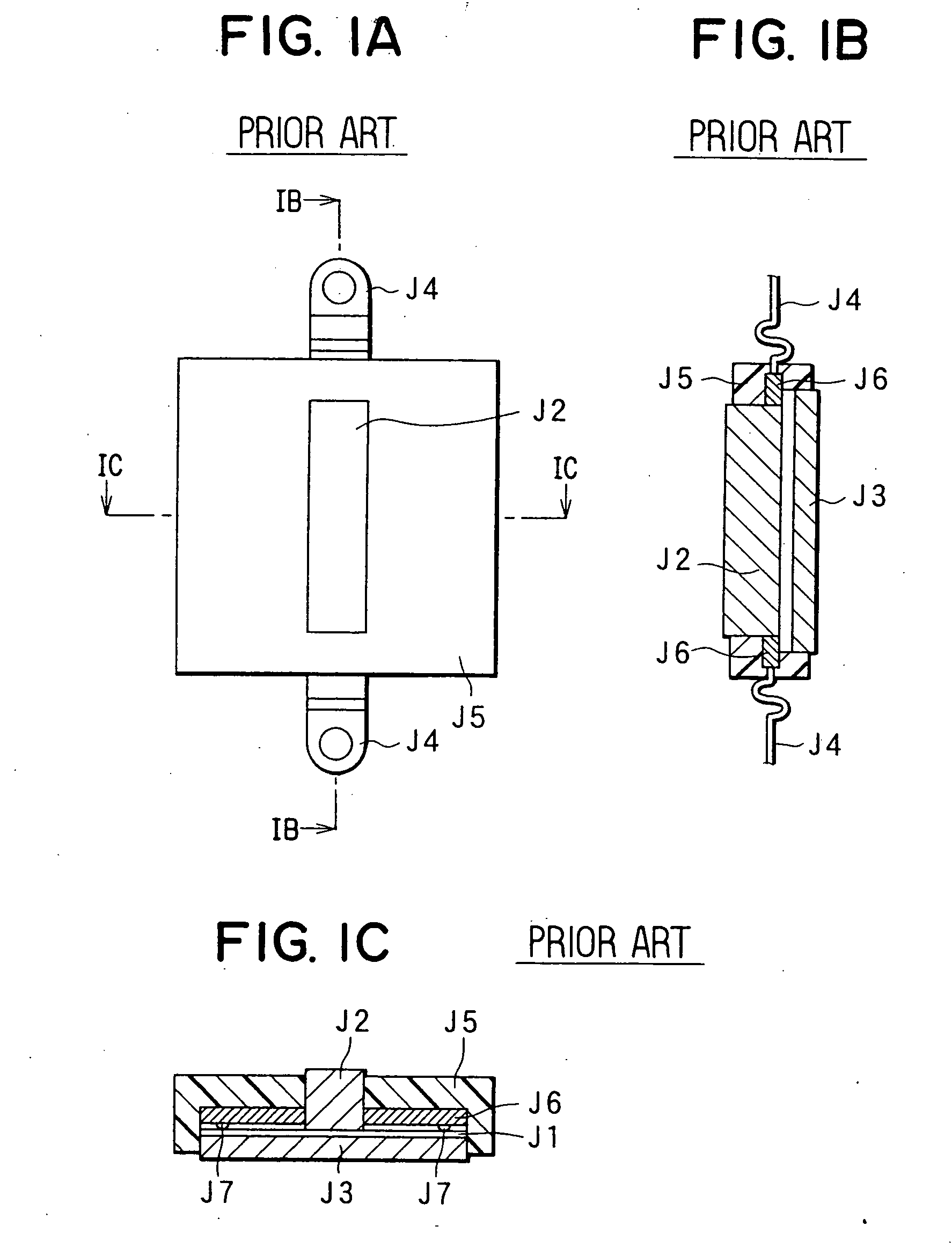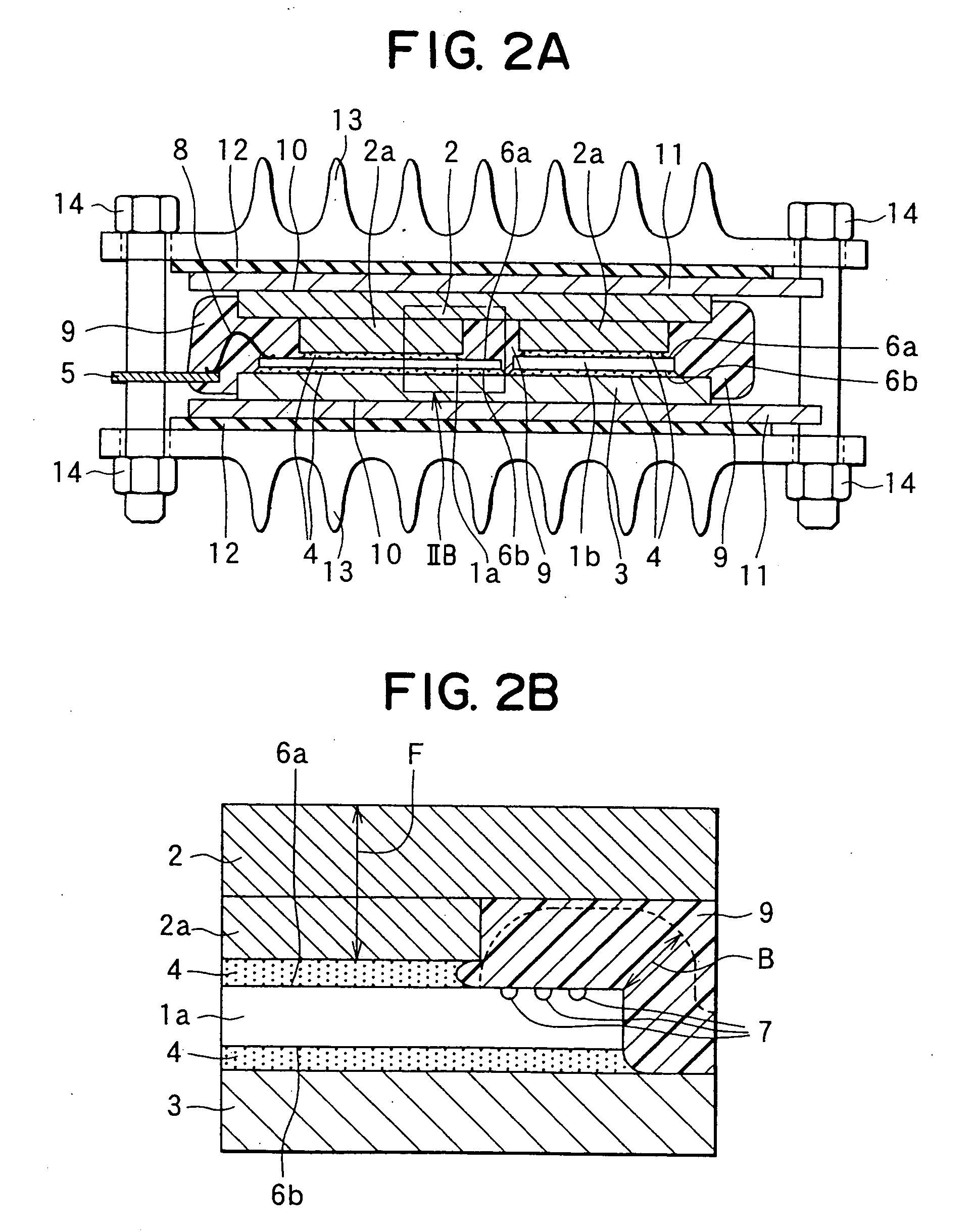Semiconductor device having radiation structure
a radiation structure and semiconductor technology, applied in the details of semiconductor/solid-state devices, semiconductor devices, electrical apparatus, etc., can solve the problems of increasing the chip size, limited disposal of different semiconductor chips in one device, and increasing the stress concentration of the first conductive member, so as to improve the radiation property and electrical conductivity of the semiconductor device, and prevent the occurrence of cracks.
- Summary
- Abstract
- Description
- Claims
- Application Information
AI Technical Summary
Benefits of technology
Problems solved by technology
Method used
Image
Examples
first embodiment
[0062] A first preferred embodiment is described with reference to FIGS. 2A and 2B. As shown in FIG. 2A, a pair of radiation members 2, 3 are disposed to sandwich two Si chips 1a, 1b that are disposed on a plane. The radiation members 2, 3 are thermally and electrically connected to principal electrodes of the Si chips 1a, 1b through bonding members 4. Hereinafter, connection means thermal and electrical connection except cases in which specific descriptions are presented. A control electrode of the Si chip 1a is electrically connected to a control terminal 5, which is connected to a lead frame, via a wire 8 formed by wire bonding.
[0063] Specifically, the radiation member (first side radiation member) 2, facing upper surfaces (first surfaces) 6a of the Si chips 1a, 1b to which the wire bonding is performed is formed with protruding portions 2a protruding at a step-like shape at positions facing the principal electrodes of the Si chips 1a, 1b. Front ends of the protruding portions 2...
second embodiment
[0091] A second preferred embodiment differs from the first embodiment in an inside shape of the first side radiation member 2. FIG. 4A shows a semiconductor device in the second embodiment, and FIGS. 4B to 4D are cross-sectional views partially showing various first side radiation members 2 and Si chips 1a, 1b facing the respective radiation members 2. FIGS. 5A to 5C are cross-sectional views respectively taken along lines VA-VA, VB-VB, VC-VC in FIGS. 4B to 4D.
[0092] In FIG. 4A, the first side radiation member 2 is partially omitted, and the cross-sectional shapes shown in FIGS. 4B to 4D are applicable to the omitted part. FIG. 4A also omits the outside wiring members 11, the high thermal conductivity insulating substrates 12, and the outside cooling members 13. Hereinafter, different portions from those in FIG. 2A are explained. In FIGS. 4A to 4D and 5A to 5C, the same parts as those in FIG. 2A are indicated with the same reference numerals, and those explanation is made simple. ...
third embodiment
[0098]FIG. 6 shows a semiconductor device in a third preferred embodiment, in which the outside wiring members 11, the high thermal conductivity insulating substrates 12, and the outside cooling members 13 shown in FIG. 2A are omitted. Hereinafter, different portions from those in the first embodiment are mainly explained, and in FIG. 6, the same parts as those in FIG. 2A are indicated with the same reference numerals.
[0099] As shown in FIG. 6, in the third embodiment, metallic members (partially disposed metallic members) 16 made of Mo, W, Cu—Mo, or the like having a thermal expansion coefficient approximate to that of Si chips are disposed at the portions of the first side and second side radiation members 2, 3 facing the Si chips 1a, 1b. The partially disposed metallic members 16 can be previously formed on the radiation members 2, 3 by soldering, brazing, shrinkage fitting, or press-fitting. To position the partially disposed metallic members 16 with respect to the Si chips 1a,...
PUM
 Login to View More
Login to View More Abstract
Description
Claims
Application Information
 Login to View More
Login to View More - R&D
- Intellectual Property
- Life Sciences
- Materials
- Tech Scout
- Unparalleled Data Quality
- Higher Quality Content
- 60% Fewer Hallucinations
Browse by: Latest US Patents, China's latest patents, Technical Efficacy Thesaurus, Application Domain, Technology Topic, Popular Technical Reports.
© 2025 PatSnap. All rights reserved.Legal|Privacy policy|Modern Slavery Act Transparency Statement|Sitemap|About US| Contact US: help@patsnap.com



